Rum, What is Rum, Types of Rum, Rum production

Rum speaks to what is Rum, types of Rum, Rum production and the distinctive flavour of such.
How to make rum explains that rum is a Caribbean drink that is distilled from sugarcane products such as molasses or sugarcane juice.
The fermentation and distillation results in a clear liquid which is aged in either oak or other wood barrels which help to flavour the rum.
As well as the Caribbean, Central and South American countries such as Guatemala, Colombia, Venezuela, Guyana and Brazil are major producers. There are also rum producers in places such as Australia, Fiji, the Philippines, India, Reunion Island, Mauritius, and elsewhere around the world.
Light rums are commonly used in cocktails, whereas golden and dark rums are also appropriate for drinking straight, or for cooking. Premium rums are also available that are made to be consumed straight or with ice.
How to make rum explains the grades and variation depend on the location that a rum was produced. Despite these variations the following terms are frequently used to describe various types of rum:
The grades and variations used to describe rum depend on the location that a rum was produced. Despite these variations the following terms are frequently used to describe various types of rum:
How to make rum explains light rums, also referred to as light, silver, and white rums. In general, light rum has very little flavor aside from a general sweetness, and serves accordingly as a base for cocktails. Light rums are sometimes filtered after aging to remove any color.
The Brazilian Cachaça is generally this type, but some varieties are more akin to "gold rums". The majority of Light Rum comes out of Puerto Rico. Their milder flavor makes them popular for use in mixed-drinks, as opposed to drinking it straight.
Gold Rums,as explained by how to make rum, is also called amber rums, are medium-bodied rums which are generally aged. These gain their dark color from aging in wooden barrels (usually the charred white oak barrels that are the byproduct of Bourbon Whiskey).
They have more flavor, and are darker-tasting than Silver Rum, and can be considered a midway-point between Silver/Light Rum and the darker varieties.
Spiced Rum: These rums, as explained in how to make rum, obtain their flavor through addition of spices and, sometimes, caramel. Most are darker in color, and based on gold rums. Some are significantly darker, while many cheaper brands are made from inexpensive white rums and darkened with artificial caramel color.
Dark Rum, also known as black rum, classes as a grade darker than gold rum. It is generally aged longer, in heavily charred barrels. Dark rum has a much stronger flavor than either light or gold rum, and hints of spices can be detected, along with a strong molasses or caramel overtone. It is used to provide substance in rum drinks, as well as color.
In addition to uses in mixed drinks, dark rum is the type of rum most commonly used in cooking. Most Dark Rum comes from areas such as Jamaica, Haiti, and Martinique, though two Central American countries, Nicaragua and Guatemala, produced two of the most award-winning dark rums in the world: Flor de Caña and Ron Zacapa Centenario, respectively.[31]
Flavored Rum: Some manufacturers have begun to sell rums which they have infused with flavors of fruits such as mango, orange, citrus, coconut or lime. These serve to flavor similarly themed tropical drinks which generally comprise less than 40% alcohol, and are also often drank neat or on the rocks.
Overproof Rum is rum which is much higher than the standard 40% alcohol. Most of these rums bear greater than 75%, in fact, and preparations of 151 to 160 proof occur commonly.
Premium Rum: As with other sipping spirits, such as Cognac and Scotch, a market exists for premium and super-premium rums. These are generally boutique brands which sell very aged and carefully produced rums. They have more character and flavor than their "mixing" counterparts, and are generally consumed without the addition of other ingredients.
Most rum produced is made from molasses. Within the Caribbean, much of this molasses is from Brazil. A notable exception is the French-speaking islands where sugarcane juice is the preferred base ingredient.
Yeast and water are added to the base ingredient to start the fermentation process. While some rum producers allow wild yeast to perform the fermentation, most use specific strains of yeast to help provide a consistent taste and predictable fermentation time. Dunder, the yeast-rich foam from previous fermentations, is the traditional yeast source in Jamaica.
The yeast employed will determine the final taste and aroma profile, says Jamaican master blender Joy Spence. Distillers that make lighter rums, such as Bacardi, prefer to use faster-working yeasts. Use of slower-working yeasts causes more esters to accumulate during fermentation, allowing for a fuller-tasting rum.
Distillation
As with all other aspects of rum production, there is no standard method used for distillation. While some producers work in batches using pot stills, most rum production is done using column still distillation.Pot still output contains more congeners than the output from column stills and thus produces a fuller-tasting rum.
Aging and blending
Many countries require that rum be aged for at least one year. This aging is commonly performed in used bourbon casks, but may also be performed in stainless steel tanks or other types of wooden casks. The aging process determines the coloring of the Rum.
It is hoped that this how to make rum information is helpful.
Return from how to make rum to homepage
Hard copy and E book for sale. What's Killing You and What You Can Do About It. Click here.
Hard copy and E book for sale. Introduction to Building Mechanical Systems. Click here.